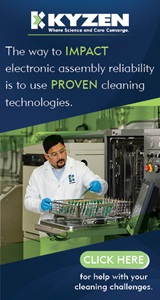|

|
|
| Ask the Experts | |||||||
|
|||||||
|
September 29, 2008 - Updated September 29, 2008 - Originally Posted Frequency range for ultrasonic cleaningWhat is the frequency range that is used when ultrasonic cleaning a pcb that has a crystal or oscillator? A. N. |
|||||||
| Expert Panel Responses | |||||||
|
Ultrasonic cleaning is specifically addressed in the J-STD-001D document. You'll find that ultrasonic cleaning is not recommended for a populated circuit board. However, if you do choose to use ultrasonic cleaning, check with the component manufacturer to establish if:
Manager of Assembly Technology IPC Kris Roberson has experience as a machine operator, machine and engineering technician and process engineer for companies including Motorola, and US Robotics. Kris is certified as an Master Instructor in IPC-7711 / 7721, IPC A-610 and IPC J-STD 001.
While the ultrasonic frequency is an important consideration, research studies have shown the Power Density and ultrasonic exposure time (cycle time) may be of equal or greater importance. There are several published articles and a copy of the IPC-7526 on the subject available for download at: SmartSonic, click on the "Recommended Reading" button. The IPC-7526, "Stencil and Misprinted Board Cleaning Handbook" summarizes these cleaning parameters on Page 6, Section 4.3 as follows:
President Smart Sonic Corporation Mr. Schreiber developed the original ultrasonic stencil cleaning process in 1989. Obtained the only EPA Verification for specific parameters of Environmental Safety, User Safety and Cleaning Efficiency for a stencil cleaning process.
In almost all cases, 20 kHz is used. A sweep frequency ensures that the actually frequency moves +/- 5 kHz. Although ultrasonic technology is effective in post-reflow and misprint defluxing, it is not commonly used as fear of damage discourages most assemblers.
President Aqueous Technologies Mr. Konrad has been in the electronic assembly equipment industry since 1985. He is founder and CEO of Aqueous Technologies Corporation, a manufacturer of automatic de-fluxing equipment, chemicals, and cleanliness testing systems.
|
|||||||
| Submit A Comment | |||||||
|
Comments are reviewed prior to posting. You must include your full name to have your comments posted. We will not post your email address. |
|
Free Newsletter Subscription
Circuitnet is built for professionals who bear the responsibility of looking ahead, imagining the future, and preparing for it. Insert Your Email Address |
|

|





